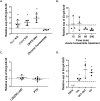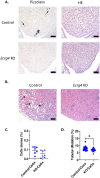Loss of Ecrg4 improves calcium oxalate nephropathy
- PMID: 36227903
- PMCID: PMC9560046
- DOI: 10.1371/journal.pone.0275972
Loss of Ecrg4 improves calcium oxalate nephropathy
Abstract
Kidney stone is one of the most frequent urinary tract diseases, affecting 10% of the population and displaying a high recurrence rate. Kidney stones are the result of salt supersaturation, including calcium and oxalate. We have previously identified Esophageal cancer-related gene 4 (Ecrg4) as being modulated by hypercalciuria. Ecrg4 was initially described as a tumor suppressor gene in the esophagus. Lately, it was shown to be involved as well in apoptosis, cell senescence, cell migration, inflammation and cell responsiveness to chemotherapy. To the best of our knowledge, nothing is known about ECRG4's function in the renal tissue and its relationship with calciuria. We hypothesized that the increased expression of Ecrg4 mRNA is triggered by hypercalciuria and might modulate intratubular calcium-oxalate precipitation. In this study, we have first (i) validated the increased Ecrg4 mRNA in several types of hypercalciuric mouse models, then (ii) described the Ecrg4 mRNA expression along the nephron and (iii) assessed ECRG4's putative role in calcium oxalate nephropathy. For this, Ecrg4 KO mice were challenged with a kidney stone-inducing diet, rich in calcium and oxalate precursor. Taken together, our study demonstrates that Ecrg4's expression is restricted mainly to the distal part of the nephron and that the Ecrg4 KO mice develop less signs of tubular obstruction and less calcium-oxalate deposits. This promotes Ecrg4 as a modulator of renal crystallization and may open the way to new therapeutic possibilities against calcium oxalate nephropathy.
Conflict of interest statement
The authors have declared that no competing interests exist.
Figures




Similar articles
-
Dietary treatment of urinary risk factors for renal stone formation. A review of CLU Working Group.Arch Ital Urol Androl. 2015 Jul 7;87(2):105-20. doi: 10.4081/aiua.2015.2.105. Arch Ital Urol Androl. 2015. PMID: 26150027 Review.
-
Changes in urinary risk profile after short-term low sodium and low calcium diet in recurrent Swiss kidney stone formers.BMC Nephrol. 2017 Dec 4;18(1):349. doi: 10.1186/s12882-017-0755-7. BMC Nephrol. 2017. PMID: 29202723 Free PMC article.
-
Calcium oxalate stone formation in genetic hypercalciuric stone-forming rats.Kidney Int. 2002 Mar;61(3):975-87. doi: 10.1046/j.1523-1755.2002.00190.x. Kidney Int. 2002. PMID: 11849452
-
Effect of Potassium Citrate on Calcium Phosphate Stones in a Model of Hypercalciuria.J Am Soc Nephrol. 2015 Dec;26(12):3001-8. doi: 10.1681/ASN.2014121223. Epub 2015 Apr 8. J Am Soc Nephrol. 2015. PMID: 25855777 Free PMC article.
-
Mechanisms Underlying Calcium Nephrolithiasis.Annu Rev Physiol. 2022 Feb 10;84:559-583. doi: 10.1146/annurev-physiol-052521-121822. Epub 2021 Oct 26. Annu Rev Physiol. 2022. PMID: 34699268 Review.
Cited by
-
Cell death‑related molecules and targets in the progression of urolithiasis (Review).Int J Mol Med. 2024 Jun;53(6):52. doi: 10.3892/ijmm.2024.5376. Epub 2024 Apr 26. Int J Mol Med. 2024. PMID: 38666544 Free PMC article. Review.
References
-
- Chen Z, Prosperi M, Bird VY. Prevalence of kidney stones in the USA: The National Health and Nutrition Evaluation Survey. Journal of Clinical Urology. 2019;12(4):296–302.
Publication types
MeSH terms
Substances
LinkOut - more resources
Full Text Sources
Medical
Molecular Biology Databases
Research Materials

